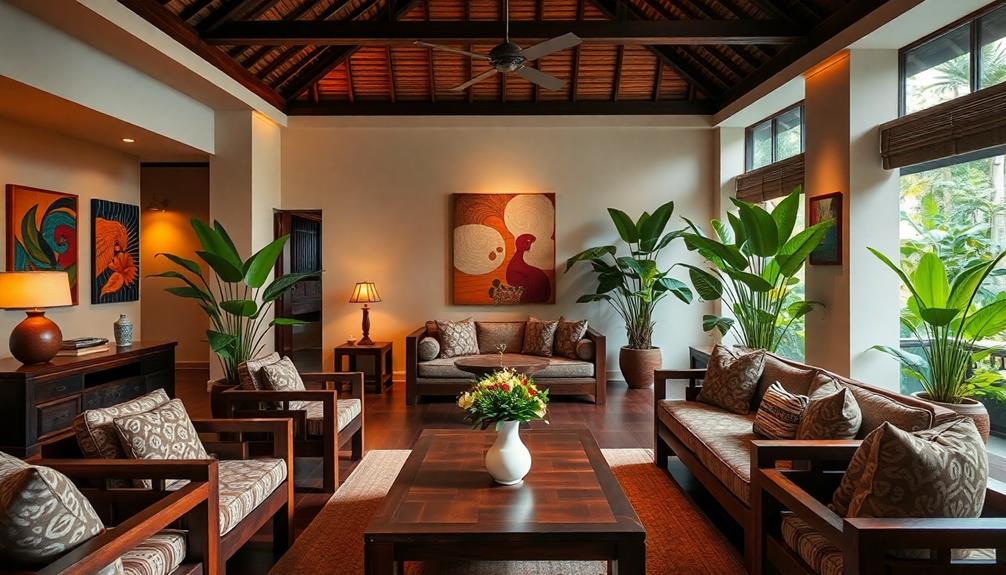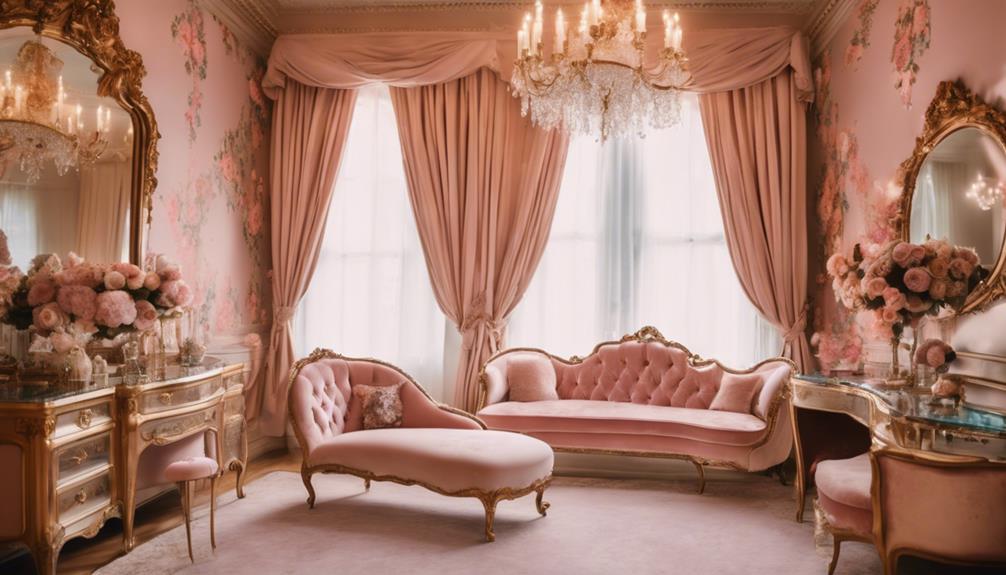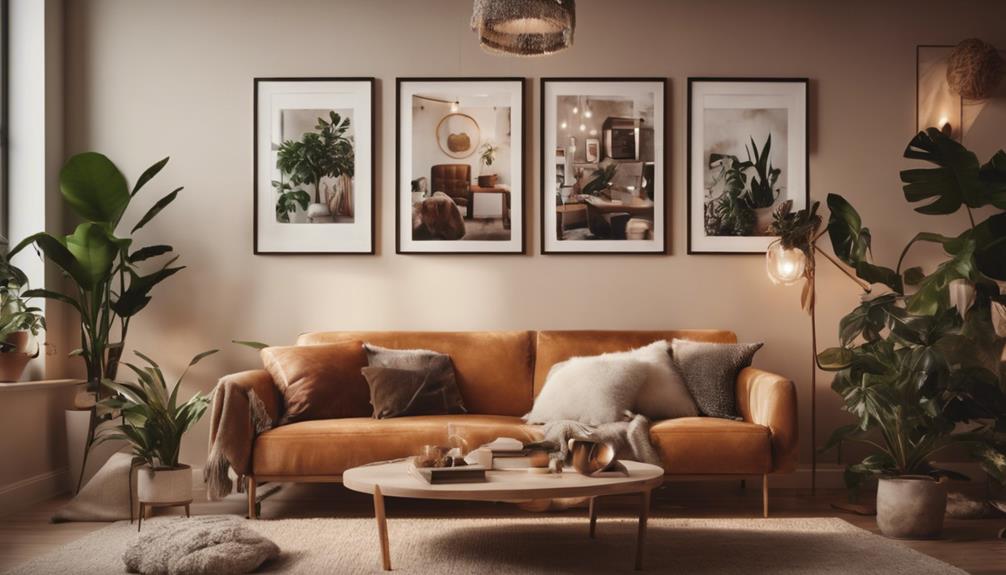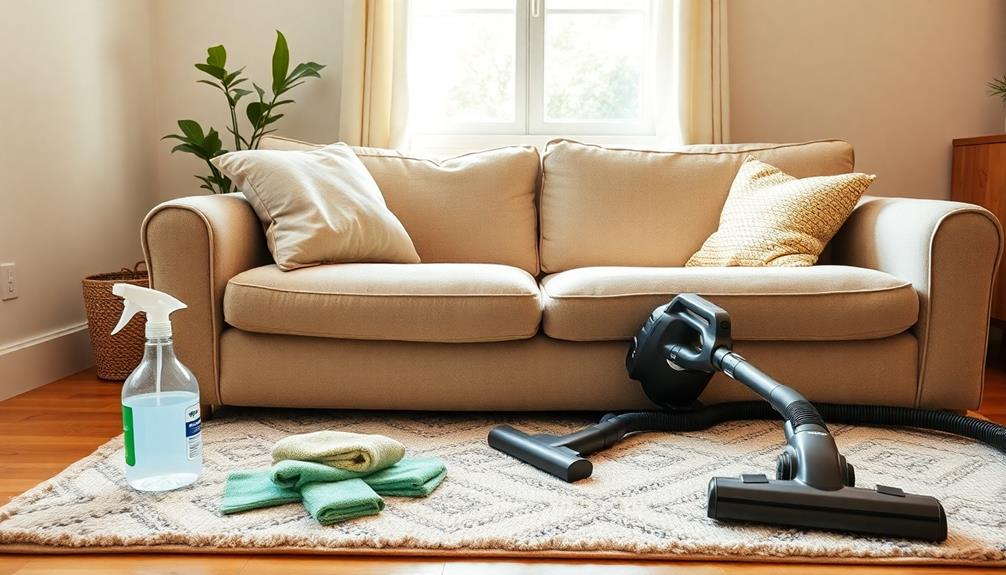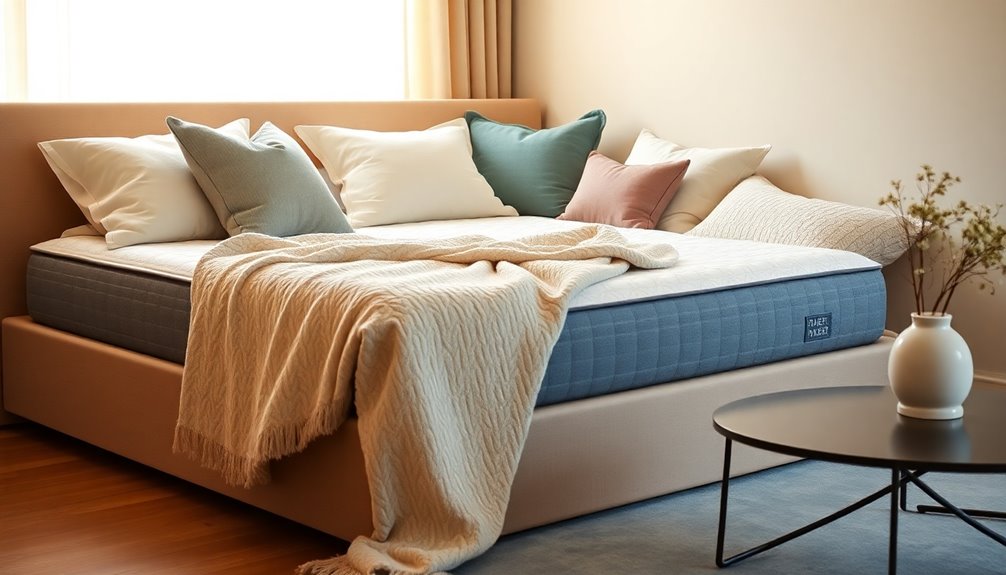Incorporating Indonesian interior design involves blending vibrant traditional elements with modern aesthetics to create a harmonious space. Utilizing natural materials such as bamboo and teak, along with earthy tones and vibrant accents, can help create a warm and peaceful atmosphere. Open layouts and large windows are used to maximize natural light and connect indoor and outdoor spaces. Including traditional textiles like batik and local craftsmanship adds cultural authenticity. Additionally, consider incorporating tropical plants and calming water features to enhance serenity and well-being. These elements come together to create an inviting atmosphere that celebrates Indonesia’s rich heritage and modern design sensibilities.
Key Takeaways
- Utilize local materials like wood, bamboo, and stone to create sustainable and authentic interiors that reflect Indonesia's rich cultural heritage.
- Incorporate traditional textiles, such as batik and ikat, to add vibrant patterns and warmth to modern design spaces.
- Design open-air layouts with large windows and sliding doors to enhance natural light and create a seamless indoor-outdoor connection.
- Blend traditional craftsmanship, like hand-carved furniture, with contemporary aesthetics to achieve a harmonious balance between old and new.
- Emphasize earthy tones with vibrant accents to evoke a sense of tranquility and energy in your interior spaces.
Indigenous Architectural Influence
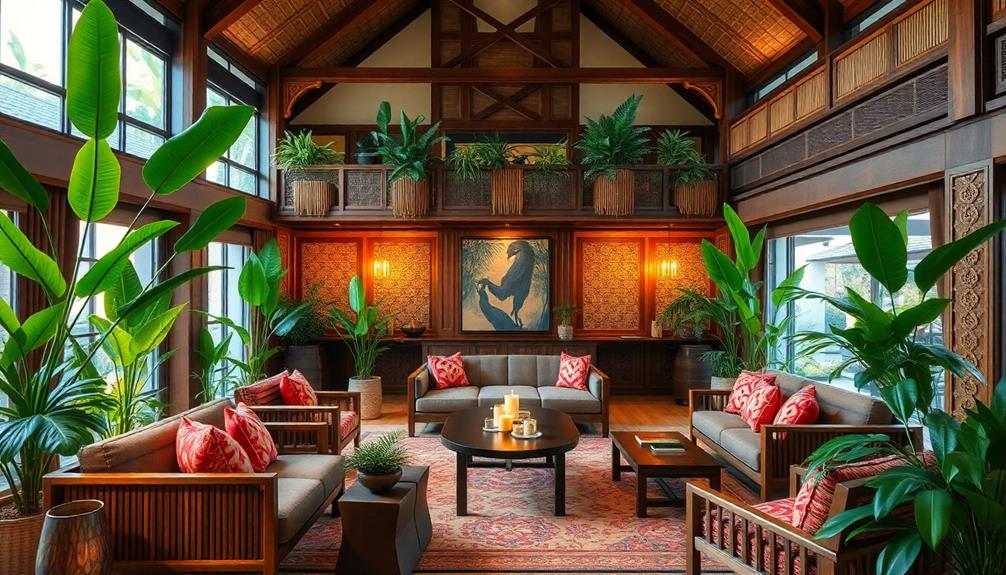
Indigenous architecture in Indonesia, with its stunning structures like Rumah Gadang and Tongkonan, plays an essential role in shaping the country's design ethos. These remarkable buildings showcase traditional elements that not only reflect cultural heritage but also inspire contemporary design.
By using local materials, indigenous architecture highlights the beauty of the environment while promoting sustainable practices. The diverse architectural styles and community-oriented layouts found in these traditional houses reinforce the importance of social interaction and cultural significance within Indonesian society, embodying a harmonious relationship with the land and its people traditional housing structures.
As you explore interior design in Indonesia, you'll notice how the principles of indigenous architecture emphasize harmony with nature. This influence encourages a seamless integration of indoor and outdoor spaces, creating an inviting atmosphere that respects the land.
Incorporating these elements into your designs can help you preserve the rich cultural narrative that defines Indonesia. When you embrace these traditions, you're not just honoring the past; you're also paving the way for a future that values sustainability and environmental consciousness.
Contemporary designs often draw upon these indigenous foundations, offering innovative solutions rooted in age-old wisdom. By understanding and applying the lessons from indigenous architecture, you can create spaces that resonate with authenticity and beauty, ensuring your designs reflect both style and tradition.
Historical Temples and Their Significance

Indonesia's architectural landscape is further enriched by its historical temples, which stand as monuments to the nation's diverse cultural and spiritual heritage. Two prominent examples are Borobudur and Prambanan, both UNESCO World Heritage Sites. Borobudur is the largest Buddhist temple globally, featuring intricate stone carvings and a stupa that symbolizes the path to enlightenment. On the other hand, Prambanan showcases stunning Hindu architectural elements with towering spires and detailed reliefs that narrate ancient epics like the Ramayana.
These temples reflect a unique aesthetic shaped by various cultural influences from the 8th and 9th centuries. Their preservation involves thorough historical research and modern technology, ensuring their structural integrity and cultural significance for future generations.
| Temple | Significance |
|---|---|
| Borobudur | Largest Buddhist temple, symbolizes enlightenment |
| Prambanan | Exemplifies Hindu architecture, tells ancient tales |
| Preservation | Combines historical research with modern techniques |
| Artistic Expression | Showcases Indonesia's rich cultural heritage |
Visiting these temples, you'll appreciate their architectural marvels and their importance as symbols of Indonesia's artistic expression and spiritual heritage.
Colonial Architecture's Legacy
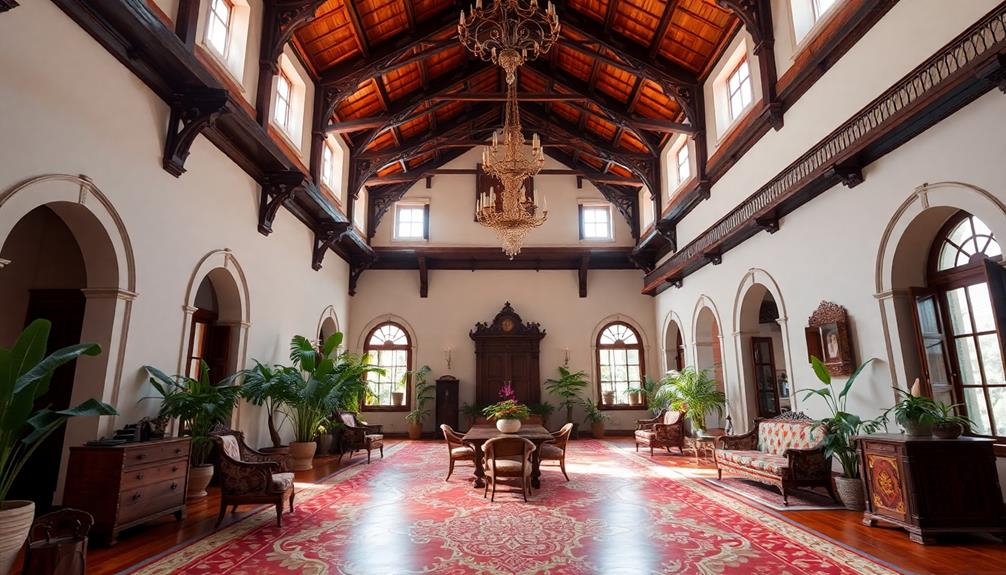
Colonial architecture in Indonesia offers a fascinating glimpse into the nation's past, showcasing a blend of European styles and local influences that have shaped its urban landscape. This architectural heritage, evident in landmarks like Kota Tua and Gedung Sate, boasts distinctive features such as large windows, high ceilings, and intricate decorative elements.
These traits not only reflect traditional craftsmanship but also continue to inspire modern design. Additionally, the integration of modern tropical aesthetics can enhance these historical features, creating an enriched visual experience that celebrates both heritage and contemporary living.
As you explore creativity in your interior, consider how colonial architecture's legacy can be integrated into contemporary spaces. By using indigenous materials and incorporating traditional styles, you can create a harmonious blend that honors the rich cultural diversity of Indonesia.
Architectural firms are already embracing this approach, weaving colonial elements into modern designs to preserve historical narratives. Incorporating these timeless aesthetics into your own projects allows you to pay homage to the past while fostering innovation.
The fusion of traditional and modern styles not only enriches your interior design but also promotes cultural tourism and preserves the historical essence of urban areas like Jakarta and Bandung. Embrace the legacy of colonial architecture and let it inspire your next design endeavor.
Principles of Sustainable Design
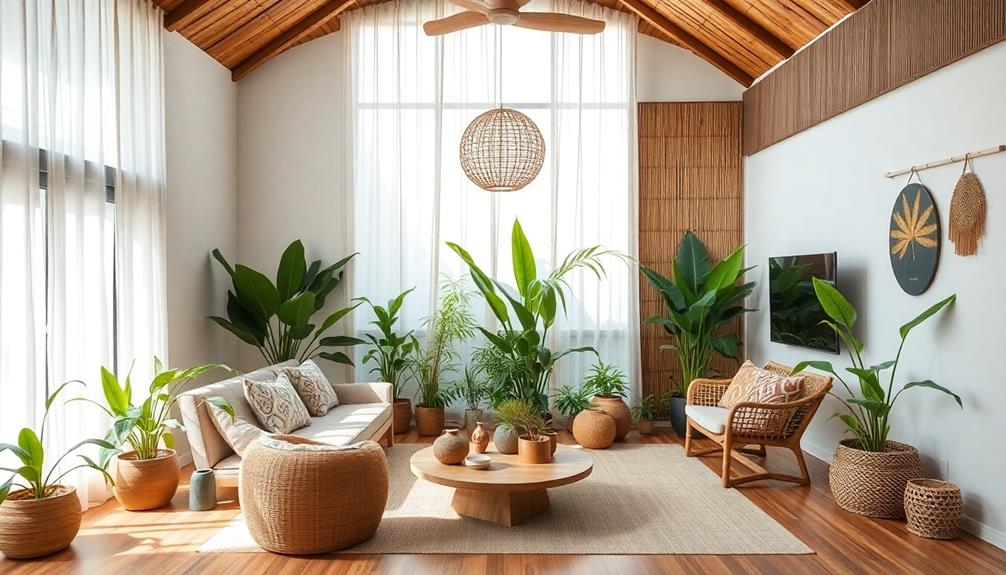
Sustainable design principles are gaining traction in contemporary interior spaces, focusing on environmentally friendly practices that resonate with both tradition and innovation.
You can embrace sustainable design by utilizing local materials like wood, bamboo, and stone, which are fundamental in Balinese Interior Design Concepts. This not only reduces your project's environmental impact but also honors traditional craftsmanship, creating a unique and culturally rich atmosphere.
Incorporating passive design strategies is essential to energy efficiency. By maximizing natural ventilation and daylighting, you minimize reliance on artificial heating and cooling systems.
Additionally, integrating water conservation techniques, such as rainwater harvesting and permeable paving, promotes responsible water usage, especially in urban environments.
Biophilic design plays an important role in your space by incorporating natural elements like plants and water features. This enhances air quality and boosts occupants' well-being, making your interior a healthier place to live or work.
Balinese Interior Design Overview
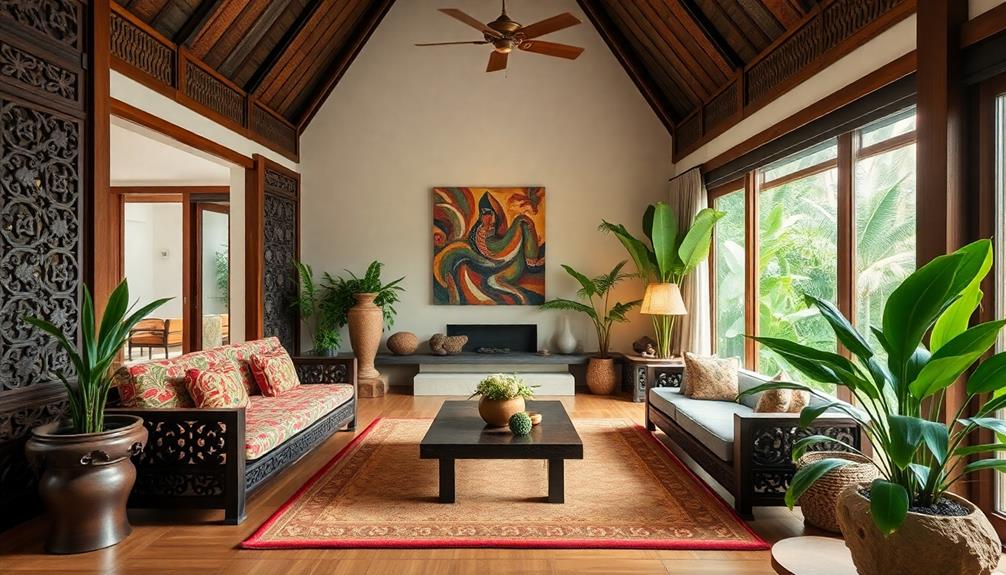
When you explore Balinese interior design, you'll notice its deep cultural significance and unique aesthetics. It blends traditional elements with modern influences, creating spaces that feel both authentic and inviting.
This style often incorporates Indonesian Decorative Pillows, which feature vibrant colors and intricate patterns that enhance living spaces. By using natural materials and vibrant colors, Balinese design promotes a harmony that reflects the island's rich heritage.
Cultural Significance of Balinese Design
The cultural significance of Balinese design lies in its ability to harmonize tradition with modernity, creating spaces that resonate with both aesthetic beauty and spiritual depth. Emerging in the early 1990s, Balinese interior design reflects the influence of architect Made Wijaya, who integrated traditional architectural styles within contemporary contexts.
This design embraces natural elements, utilizing materials like wood, stone, and bamboo, which promote warmth and sustainability. Earthy tones dominate the palette, evoking tranquility and cultural meaning, while open-air layouts blur the lines between indoor and outdoor spaces, inviting nature inside.
Incorporating traditional textiles and artistic ornaments, such as batik and intricate wood carvings, enriches the interior, adding layers of cultural authenticity. These elements are not just decorative; they tell stories and connect you to Balinese heritage.
| Element | Significance | Example |
|---|---|---|
| Traditional Patterns | Cultural identity | Batik textiles |
| Natural Elements | Sustainability and warmth | Bamboo and stone |
| Earthy Tones | Tranquility and harmony | Soft browns and greens |
Key Features of Aesthetics
Key features of Balinese interior design create an inviting and harmonious atmosphere that seamlessly blends nature with aesthetics.
You'll notice the emphasis on natural materials like wood, stone, bamboo, and rattan, which promote sustainability and warmth in your space. The incorporation of intricate carvings and regional crafts further enhances the cultural significance of the design, showcasing the beauty of traditional Indonesian style home decor.
The open-air designs, characterized by large windows and sliding doors, invite the outdoors in, enhancing the connection between your interior and the lush surroundings.
The color palette is another highlight, featuring earthy tones like browns and greens paired with vibrant accents such as deep reds and golds. This evokes a sense of tranquility while celebrating cultural richness.
To enhance cultural authenticity, traditional textiles, including batik and ikat, are integrated throughout the decor, adding unique character to your environment.
Water features, such as ponds or fountains, bring a serene ambiance, while tropical plants further reinforce the connection to nature, making your space feel alive.
By incorporating these key elements, you create a Balinese-inspired interior that not only looks beautiful but also feels grounded and connected to its cultural roots.
Embrace these features to transform your home into a peaceful sanctuary.
Key Features of Balinese Style
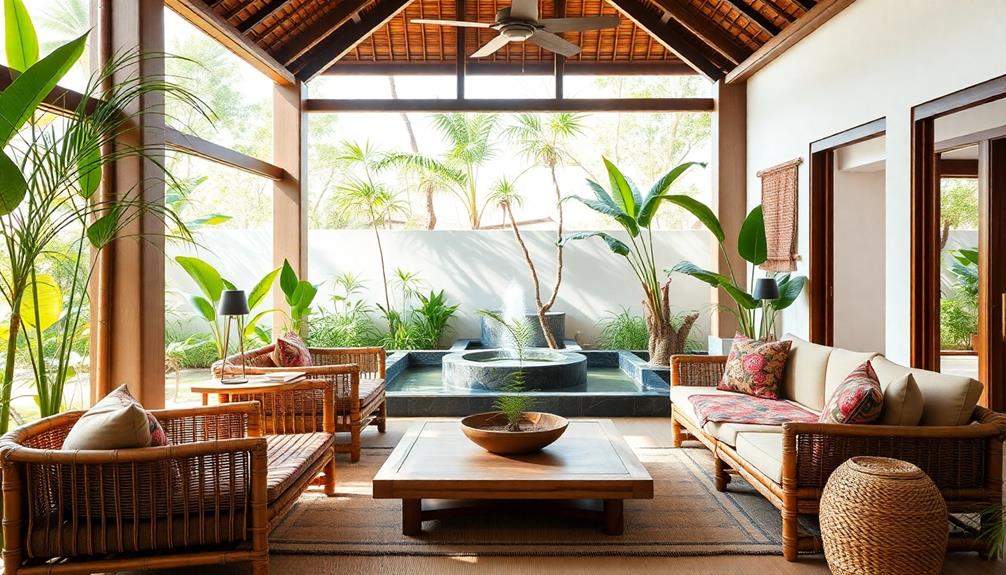
When you explore Balinese style, you'll notice how it embraces natural materials and open space design. This approach not only creates a seamless flow between indoor and outdoor areas but also fosters a strong connection to nature.
Natural Materials Utilization
Embracing natural materials is central to Balinese interior design, creating spaces that exude warmth and sustainability. This approach not only reflects the rich cultural heritage of Indonesia but also highlights the importance of craftsmanship, as seen in the creation of traditional artistry that enhances the aesthetic appeal and deepens the connection to nature.
Here are four key aspects of natural materials in Balinese style:
- Wood: Teak wood is often chosen for hand-carved furniture, showcasing traditional craftsmanship and durability. Its rich tones add depth to your spaces.
- Traditional Textiles: Fabrics like batik and ikat are integral to Balinese decor. These textiles bring cultural authenticity and vibrant patterns, enhancing the overall design.
- Volcanic Rock: Incorporating volcanic rock or river stone in flooring provides a grounded, organic feel. It's not just about looks; it connects your interiors to the island's natural landscape.
- Thatched Roofs: Alang-alang grass is commonly used for thatched roofs. This not only offers insulation but also adds to the aesthetic charm, a hallmark of Balinese architecture.
Open Space Design
Open space design in Balinese style creates an inviting atmosphere that seamlessly blends indoor and outdoor living. This design approach emphasizes the connection between your indoor and outdoor areas, allowing for a fluid passage that enhances natural airflow and light.
With large windows and sliding doors, you can maximize natural light, fostering a bright and airy ambiance that's characteristic of Balinese architecture. By incorporating elements from tropical villa plans, such as outdoor living areas and local materials, you can enrich the overall aesthetic and functionality of your space.
The open floor plans encourage movement and unobstructed views, promoting a sense of freedom and a connection to the surrounding environment. By incorporating natural materials like wood and stone, you reinforce this bond with nature, creating a serene and inviting atmosphere.
Thatched roofs made from alang-alang grass not only enhance aesthetic appeal but also provide insulation, ensuring comfort in tropical climates.
In Balinese style, open space design is more than just a layout; it's a lifestyle that embraces the beauty of nature and encourages harmony within your home. By focusing on seamless integration and maximizing natural elements, you can create an environment that feels both expansive and intimate, blending the charm of traditional Balinese design with modern living.
Integration of Nature
The integration of nature in Balinese interior design transforms your living space into a serene retreat that enhances well-being.
By embracing natural elements, you create an environment that fosters peace and tranquility. This approach is often exemplified by firms like Mahallati Interiors that specialize in luxury tropical design aesthetics, ensuring a perfect blend of comfort and elegance.
Here are some key features that define this harmonious style:
- Open-Air Layouts: Balinese designs emphasize seamless connections between indoor and outdoor spaces, allowing fresh air and natural light to flow freely throughout your home.
- Natural Materials: Utilizing materials like wood, stone, and bamboo adds warmth to interiors while promoting sustainability. These elements reflect the beauty of the natural world.
- Tropical Plants and Water Features: Incorporating lush tropical plants and soothing water features, like ponds or fountains, enhances the ambiance and improves air quality, creating a revitalizing atmosphere.
- Textural Variety: Implementing diverse textures, such as volcanic rock or river stone flooring, reinforces the organic feel of your space, contributing to a tranquil environment.
Blending Traditional and Modern Elements
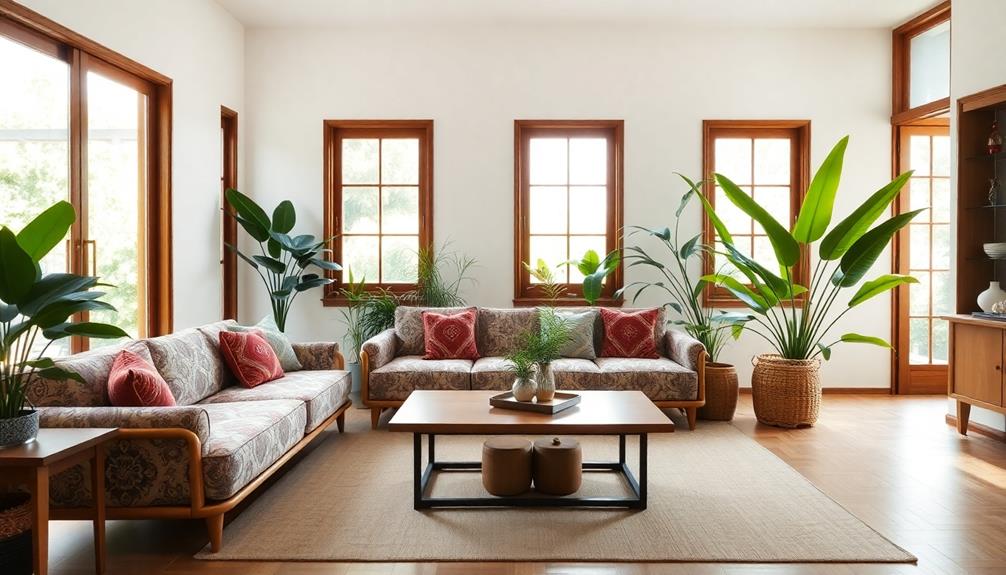
Blending Traditional and Modern Elements
In Indonesian interior design, blending traditional and modern elements creates an alluring synergy that transforms spaces into reflections of cultural heritage and contemporary style. The fusion of old and new design elements emphasizes a harmonious balance, where traditional craftsmanship, such as beautifully crafted Indonesian Decor Masks, is seamlessly integrated with modern aesthetics. Natural materials such as teak wood, rattan, and bamboo are often used to enhance the authenticity of the space, while minimalist furnishings and clean lines maintain a modern, uncluttered feel. For those seeking Indonesian restaurant design tips, it’s essential to incorporate warm lighting, earthy tones, and strategic placement of traditional art pieces to create an inviting ambiance that resonates with Indonesia’s rich cultural landscape. Moreover, authentic Indonesian interior design often incorporates intricate batik textiles and traditional pottery, adding layers of history and texture to any space. Whether creating a cozy home or an inviting commercial establishment, the key to achieving authentic Indonesian interior design lies in thoughtfully balancing heritage-rich elements with modern comforts. This approach not only enhances the aesthetic appeal but also ensures that each space remains deeply connected to Indonesia’s cultural roots.
You can achieve this by incorporating natural materials like teak wood and bamboo, which aren't only sustainable but also lend warmth to your interiors.
Utilizing traditional textiles such as batik and ikat adds rich cultural authenticity, enhancing visually appealing spaces that complement sleek, minimalist furnishings.
When selecting color palettes, consider earthy tones paired with vibrant accents to evoke tranquility and energy, reflecting both traditional and modern influences.
Interior design projects that successfully blend these elements often tell a unique story, showcasing the thoughtful juxtaposition of old and new.
Designers at WeDezine Studio exemplify this approach, crafting enchanting environments that resonate with both history and innovation.
Creating Harmonious Living Spaces
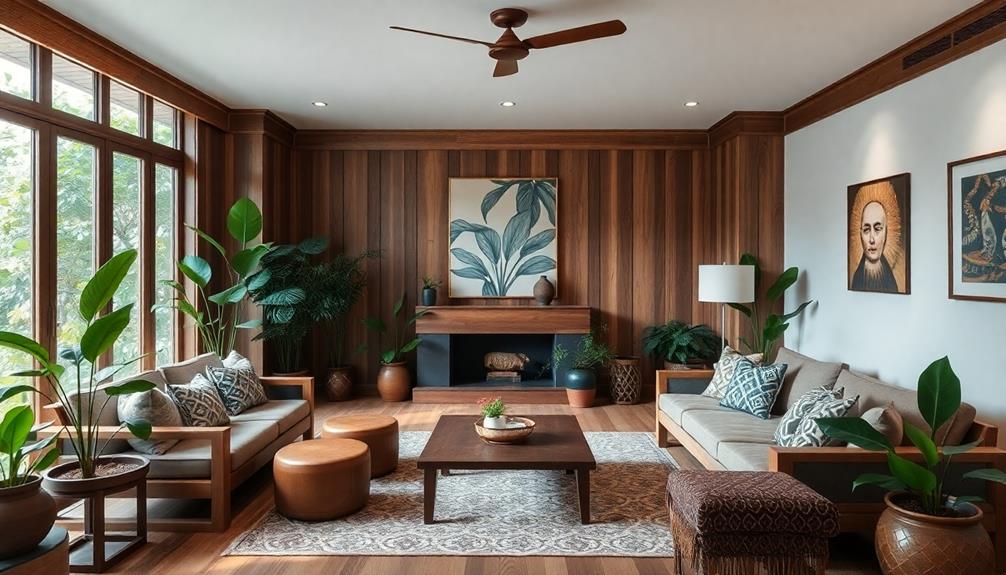
Creating harmonious living spaces in Indonesian interior design means integrating traditional elements with modern features to reflect the rich cultural heritage while meeting today's needs. Incorporating unique pieces like Indonesian decor masks can enhance the aesthetic appeal and serve as a conversation starter, showcasing the intricate designs that depict local myths and folklore the importance of decor masks.
To achieve this harmonious blend, consider the following key aspects:
- Traditional elements: Incorporate batik textiles and wooden carvings to add authenticity and warmth to your space.
- Modern design features: Embrace open floor plans and large windows to promote natural light and a seamless indoor-outdoor connection.
- Cohesive color palette: Use earthy tones combined with vibrant accents to evoke feelings of tranquility and create a welcoming atmosphere.
- Nature-inspired elements: Integrate tropical plants and water features to enhance air quality and reinforce the serene vibe characteristic of Indonesian design.
The Role of Nature in Design

Nature plays a pivotal role in Indonesian interior design, seamlessly blending indoor and outdoor environments. By incorporating tropical plants like palms and ferns, you not only enhance air quality but also reinforce the region's natural beauty and vibrant tropical vibe. These lush elements contribute to a serene environment, making your space feel alive and inviting.
Water features, such as ponds or fountains, are integral in introducing calming sounds that promote tranquility. Imagine the soothing ambiance created by gentle water flow, enhancing your overall atmosphere.
Additionally, using natural materials like volcanic rock or river stone for flooring offers a grounded feel, connecting your living space to the earth and creating an organic aesthetic.
Open-air designs, a hallmark of Balinese architecture, blur the lines between indoor and outdoor spaces, maximizing natural light and creating a liberating atmosphere. By emphasizing a harmonious mix of textures and materials, you foster a sense of serenity and balance.
This approach not only enhances your living space but also cultivates a deeper connection to nature, allowing you to experience the richness and tranquility of Indonesia in your home.
Frequently Asked Questions
What Is Harmony Interior Design?
Harmony in interior design means blending elements like color, texture, and form to create a cohesive space. You'll want to focus on proportion, scale, and a limited color palette for a serene, inviting atmosphere.
What Is Traditional Style Interior Design?
Imagine stepping into a timeless story; traditional style interior design weaves history into every corner, combining elegant moldings and rich woods. You'll feel warmth through muted tones, intricate patterns, and the soul of craftsmanship.
What Is the Idea of Feng Shui Interior Design in the Chinese Tradition?
Feng Shui interior design focuses on arranging your space to enhance harmony and balance. You'll use natural materials, specific colors, and decluttering techniques to promote positive energy flow, creating a more inviting and peaceful environment.
What Is Balinese Interior Design Style?
Imagine stepping into a serene sanctuary, where natural wood whispers of the forest, and vibrant textiles dance with sunlight. Balinese interior design embraces open spaces, earthy tones, and cultural elements, creating an enchanting, tranquil atmosphere.
Conclusion
In Indonesia, blending style and tradition isn't just a design choice; it's an art form that transforms your living space into a vibrant tapestry of culture! Imagine walking into a home where every corner tells a story, and every color dances with meaning. By embracing these rich influences, you're not just decorating—you're crafting a masterpiece that resonates with the spirit of the archipelago. So go ahead, let your home sing with the harmonious echoes of Indonesia's incredible design heritage!
